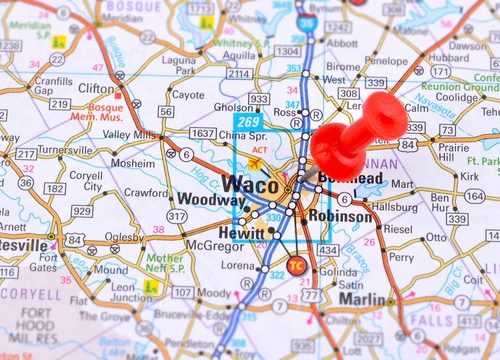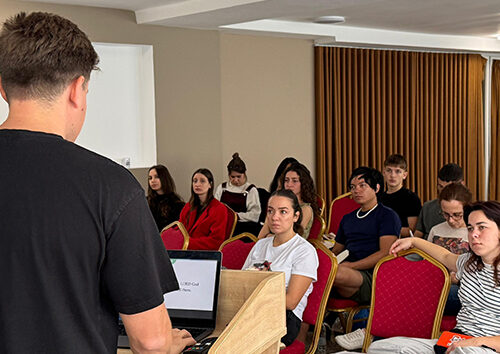March 23 | Bracknell, UK [Dr Steve Currow]
The devastating loss of life, especially that of children, in the siege of the Branch Davidians at Waco on 19 April 1993 was tragic. As highlighted in the media coverage of the event and the subsequent trials and inquiries, the alleged failure of the authorities in the way they responded and managed the case was astonishing. However, what’s even more astonishing to me is that people followed David Koresh in the first place.
Continuities
As various authors have demonstrated,(1) there can be no denying that there are points of connection between Koresh’s Branch Davidians and the Seventh-day Adventist Church. Koresh himself had been a Seventh-day Adventist for a couple of years before joining the Branch Davidians.(2) The Branch Davidians trace their roots to the teachings of Victor Houteff. Houteff’s teachings were rejected by both his local Seventh-day Adventist church in Los Angeles (1930)(3) and the corporate church (1934).(4)
Despite being disfellowshipped (a process by which a person is removed from membership of the Adventist Church), Houteff continued to claim that he was a Seventh-day Adventist; and, through his publication, The Shepherd’s Rod, and other means, pursued a mission to call for reform in the Seventh-day Adventist Church. Indeed, Houteff only formalised the name The Shepherd’s Rod Seventh-day Adventists to enable his pacifist followers to avoid conscription during World War II.(5)
Not only do the Branch Davidians recognise Ellen G. White, considered a prophet by Seventh-day Adventists, as one of their Seven Shepherds (6) and reference her writings extensively, but the Branch Davidians also share presuppositions with Seventh-day Adventists regarding, for example, an emphasis on the end of time, the emergence of latter-day prophets, and the concept of ‘present truth’. In addition, Branch Davidians’ beliefs and practices are still evident to a greater or lesser degree in some groups on the edges of Seventh-day Adventism; and, in the spirit of Houteff’s mission to reform, Branch Davidians continue to recruit primarily from the Seventh-day Adventist Church.(7) Even after the Manchester Inquest into the deaths of Britons during the Waco siege, while the church was still in horror and shock, a Branch Davidian was found to be recruiting disaffected members at the 1997 South England Conference camp meeting.(8)
Historical background
In a journey spanning over 60 years, and involving several leadership crises, Houteff’s Shepherd’s Rod morphed into David Koresh’s Branch Davidians, a group that today’s Seventh-day Adventists do not recognise and one that is not part of the Seventh-day Adventist Church.
Theologically, one of the ways in which Victor Houteff diverged from the Seventh-day Adventist Church was through his literal interpretation of the characteristics and identity of the 144,000 of Revelation chapter 7. He linked his interpretation with both perfectionism– an unbiblical teaching stemming largely from the work of M. L. Andreason that suggests believers need to attain a state of sinlessness before Christ’s return – and, over time, a literal return of Jesus to the newly emerging nation of Israel. In 1935 Victor moved from Los Angeles, CA to Waco, TX, anticipating a move to Palestine with the 144,000 within a year or so.(9)
After his unexpected death, Florence Houteff, Victor’s much younger second wife, assumed the leadership. Along with her leaders, she predicted that Jesus would return on 22 April 1959. She called all their followers to Mt Carmel, the name of the property in Waco, TX, for the Passover, prior to relocating to Israel as and when revealed by the Holy Spirit. When Jesus didn’t return at the specified time, the Shepherd’s Rod splintered into several groups.(10) In 1962, Florence herself renounced the teachings and closed the church.(11)
During this tumultuous period after the death of Victor, Benjamin Roden, a convert from Judaism, assumed the leadership of the group and became the lawful owner of the property. The links with Judaism and the nation of Israel grew. He established a vegetarian village in Israel (1958) and settlers’ rights (1960) for his followers.(12) More emphasis was placed on the seven festivals of the sanctuary.(13) Just before the death of Benjamin in 1978, Lois Roden claimed that she had received a revelation that the Holy Spirit was female and subsequently commenced her publication SHEkinah, edited by a long-term follower, Perry Jones.(14) Hence, she also assumed the leadership, and, using a legal injunction, excluded her son, George Roden, from leadership, as she did not think he was fit to be the next prophet.(15)
With the emergence of feminist theology in other Christian circles, Lois’s emphasis on the Holy Spirit as female propelled her onto the wider stage at a number of Christian conferences. After being asked to leave the Tyler Seventh-day Adventist church, Vernon Howell (who later changed his name to David Koresh) arrived at Mt Carmel in 1981. (16) He was well received as a carpenter, and after a few months he went to California to pursue a career in the music industry. He was unsuccessful, and on his return in 1983 he impressed Lois Roden, who endorsed him as the next prophet and called her followers to come to Mt Carmel and hear him speak.(17)
At this time, he was intimately involved with Lois Roden, so that the child of the prophet would be the Chosen One.(18) George claimed that the relationship had commenced with rape, and reported Howell to the authorities.(19) The relationship ended early in 1984 on the day when Howell married Rachel Jones, the 14-year-old daughter of Perry and Mary Bell Jones – long-time followers of The Shepherd’s Rod (in Texas, at this point in time, girls aged 14 were legally able to marry with parental permission).
At every opportunity, George continued to challenge Howell in a tussle over leadership. After a fire at their press building, George, on the basis of alleged eyewitness testimony, accused Howell of setting it.(20) As a result, the group split, with some following George, but the majority following Howell. Howell had to leave the Mt Carmel property. The ultimate showdown between George and Howell occurred when George challenged Vernon as to who could resurrect Anna Hughes, a believer who had died at Mt Carmel some twenty years earlier. Howell, with seven followers, entered the Mt Carmel property and, while allegedly trying to gain evidence that George had interfered with the corpse, was involved in a shoot-out that left George injured. This resulted in a court case where Howell’s accomplices were acquitted and Howell’s case ended in a mistrial.(21) George Roden was sent to jail for contempt of court and for disregarding his mother’s earlier legal injunction excluding him from leadership. Howell returned to Mt Carmel and paid the back taxes to establish himself there.(22)
Howell visited Israel; Australia (with Clive Doyle, a long-term follower of the Branch Davidians); Hawaii; and the UK, recruiting followers.(23) The first significant recruit was Marc Breault (1986), who subsequently recruited Steve Schneider (1986), an active church member in the Diamond Head Adventist Church, Hawaii.(24)
Schneider visited the UK (1988, 1990) and based much of his recruitment activity around Newbold College. His focus was on Koresh’s self-belief in his ability to unlock and explain the seventh seal spoken of in Revelation 8:1 – something only the Lamb of God could do. He was remembered for using the phrase, ‘the truth that will blow your mind’ Koresh’s visit in 1988 and 1989 followed up the interests Schneider had made. At Newbold, they were successful in influencing Livingstone Fagan, John McBean and Cliff Sellors. Fagan was most influential in the Nottingham area, McBean in the Manchester area, and Cliff Sellors and others in the London area.(25) Followers were encouraged to go to Mt Carmel for the Jewish festivals and the summers. A number also moved there with their families. Some family members were successful in encouraging their relatives to leave Mt Carmel and return.
In August 1989, Howell released an audio tape titled ‘New Light’. This tape reported his claim that God had told him to procreate with all the women in the group to establish the ‘House of David’. He also claimed that God had told him to start building an ‘army for God’ to prepare for the end of days and the salvation of his followers.(26) At this point some of the Branch Davidians, such as Marc Breault, left the group and warned others, including the authorities, of several issues on the compound, including polygamy, sexual relationships with underage girls, and child abuse.(27) Later, a courier delivering a broken package became aware of probable infringements of the Firearms Act and reported this to the authorities.(28)
In 1993, these developments led to the raid on 28 February and the start of the siege by federal agents that, after 51 days, culminated in a fire and the discovery of 75 bodies, 25 of which were children. It is also noted that the Waco Tribune-Herald published articles on the ‘Sinful Messiah’ on Saturday 27 February, detailing the illegal activities at Mt Carmel and noting that ‘the law watches, but has done little’.(29)
Subsequent to the end of the siege, the dispute over the title of the property continued, with George Roden’s divorced wife, Amo, claiming ownership. Clive Doyle and other followers remained on the site and built a chapel.(30) As of 2006, some of their followers were still expecting David Koresh to return to this earth, despite him not returning in December 1996 or late August 1999 as they had calculated.(31)
Having identified some of the primary points of contact between Koresh’s Branch Davidians and the Seventh-day Adventist Church, and the development of the movement from Victor Houteff to Vernon Howell (David Koresh), I will now proceed to outline those elements that might appropriately be described as major points of discontinuity. The graphic above summarises a range of theological developments that emerged. These changes demonstrate a tremendous shift in belief and practice, arising from someone who claimed authority directly from God. The focus moves from a rational study of Scripture to following the sensational ramblings of a charismatic leader whose word ‘was gospel’.(32)
The onus is on each one of us to ensure that we are diligent students of the Bible, and, like the Bereans, test teachings by the Scriptures so that we can be sure of what we believe (Acts 17:10, 11). We need to have confidence in the sufficiency of the ministry of Jesus and the resultant assurance of salvation (Romans 8:1). We need to live authentically, with our actions being congruent with our beliefs. We need to teach people to swim in any context, rather than damming the ocean and living as a recluse.33 Jesus’ commission remains: ‘As the Father has sent me, so I send you’ (John 20:21, NRSV).
(1) Cari Hoyt Haus and Madlyn Lewis Hamblin, In the Wake of Waco: Why Were Adventists Among the Victims? (Hagerstown, MD: Review & Herald, 1993), pp. 141-158; Kenneth G. C. Newport, The Branch Davidians of Waco: The History and Beliefs of an Apocalyptic Sect (Oxford: Oxford University Press, 2006); James D. Tabor and Eugene V. Gallagher, Why Waco? (Berkley, CA: University of California Press, 1995) pp. 43-51. (2) Albert A. C. Waite, ‘From Seventh-day Adventism to David Koresh: the British Connection’, AUSS, vol. 38, no. 1, spring 2000, p. 112 (3) William Claiborne and Jim McGee, ‘The Making of David Koresh’, Spectrum, vol. 23, no. 1, May 1993, p. 18 (4)Tabor and Gallagher, p. 35 (5) George W. Reid, ‘The Branch Davidians/Shepherd’s Rod – Who Are They?’ Adventist Review, 1 April 1993, pp. 6, 7 (6) Kendra Haloviak Valentine, ‘The Waco Wars Revealed: Reflecting on Waco 25 Years Later’, Spectrum Magazine (accessed 18 February 2023), p. 12 (7) Catherine Wessinger, Branch Davidians, 1981-2006: An Extended Profile, with Material from Internal FBI Documents, Academia (accessed 22 February 2023), p. 7 (8) David Marshall, ‘Editorial: Steady As She Goes’, Messenger, vol. 102, no. 21, 10 October 1997, p. 3 (9) Tabor and Gallagher, p. 37 (10) Lowell Tarling, The Edges of Adventism (Bermagui South, NSW: Galilee), pp. 125-142 (11) Reid, pp. 6, 7 (12) Newport, pp. 123, 124; and The Two Branches (accessed 26 February 2023) (13) Tabor and Gallagher, p. 39 (14) Waite, p. 114 (15) Tommy Witherspoon, ‘District Judge throws out Roden’s leadership lawsuit’, 28 January 198 (accessed 26 February 2023) (16) Waite, pp. 112, 113 (17) Wessinger, p. 1 (18) Tabor and Gallagher, p. 41 (19) Wessinger, p. 1 (20) Wikipedia (21) Waite, p. 116 (22) Wikipedia (23) Wessinger, pp. 1, 2 (24) Joel Sandfur and Charles Liu, ‘Apocalypse at Diamond Head: Remembering Waco’, Spectrum, vol. 30, no.1, May 1993, p. 3 (25) Albert A. C. Waite and Laura Osei, ‘The British Connection’, Spectrum, vol. 23, no. 1, spring 1993, pp. 36-38 (26) Ashley Fantz, ‘Who was David Koresh?’ (accessed 26 February 2023) (27) Waite, p. 119 (28) Peter Van Saint, ‘I’ve kept my story secret for the last 25 years – I didn’t want to take this to my grave’, CBS 48 Hours (accessed 11 January 2023) (29) Mark England and Darlene McCormack, ‘Sinful Messiah – 7-part series’, Waco Tribune-Herald, 27 February 1993 (accessed 2 February 2023) (30) Newport, p. 178 (31) Newport, p. 329 (32) Haus and Hamblin, p. 95 (33) Caleb Rosado, ‘Lessons from Waco II’, Ministry, vol. 66, no. 8, August 1993, p. 18
Dr Steve Currow is the Principal of Newbold College of Higher Education, Bracknell, UK
This article originally appeared in The Messenger, the official journal of the Seventh-day Adventist Church in the United Kingdom and Ireland.




